|
Gooding #6F1
BPA - Sperati First Reproduction (Page 134)
Jean de Sperati
Forgery. Photo-Lithographed forgery closely resembling the first
variety. Stamp colour is bright red, dull red or dull pink. The paper is a
little harder and somewhat thinner than the genuine. On the inner frame line
at top there is a dot above the 'S' of 'CORREOS'. The frame lines above the
'1' in '1854' are joined by a diagonal coloured stroke. Small coloured dot
between the frame lines above the '4' in '1854'. No period or Stop after the
date '55'. Diagonal stroke of colour in the right frame line 5mm from the top
and this frame line is largely retouched in the negative. Bottom serif of 'F'
in 'FRANCO' is curved. Die proofs exist in black and in colour as well as
unused and used reproductions. Some copies are known with a 'Sperati Reproduction' handstamp in purple on the back.
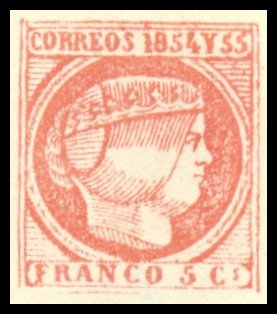
Gooding #6F2
The 'O' in 'CORREOS' is broken at the top left corner. The 'E'
in 'CORREOS' is broken at the base line. The 'S' in 'CORREOS' is tall and
slender with very small loop on top. Loop of
'5' in '1854' is not as wide as the original. Colon after '5' in '55'. The 'N' in
'FRANCO' is broken on the right bottom. Wavy lines instead of circles of
pearls in top left corner.
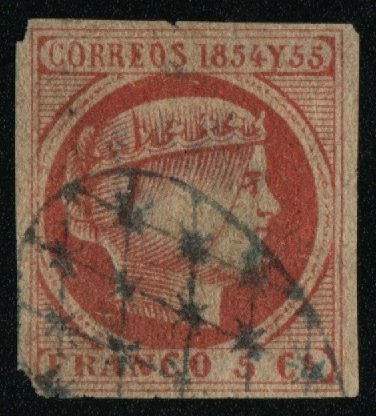
Gooding #6F3
Robson Lowe (Schroder, Page 9)
Oswald Shroder
Forgery. Lithographed in Manila
in dull brick red. Forgery closely resembles stamp Position #2 in the block.
The '8' in '1854' is somewhat diagonal compared to the other numbers. The thin
soft paper on which the forgery is printed is very like that of the genuine.
The brow and eye are too heavy when compared with the genuine. The figure '5'
in the value is too small. The lettering has been retouched and will not
stand comparison with the genuine. The size of the forgery is 20.25 x 22.25
mm.
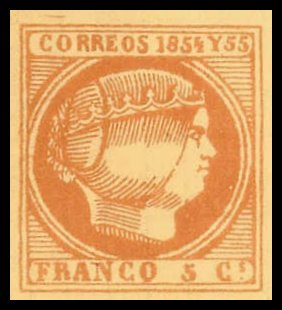
Gooding #6F4
Coarse imitation and easily identifiable. The First 'R' in
'CORREOS' has thin downward stroke. Second 'R' is broken at the bottom of the
downward stroke. Bottom loop in the first '5' in '55' is broken. Broken frame
line below first '5' in '55'. The 'R' in 'FRANCO' has thin downward stroke
and is broken at the bottom. The right serif of the 'N' is broken on the
right upright. Top curve in 'C' is broken. Frame line is broken on the right
side of the value tablet. Horizontal line at the top of the right spandrel is
missing. Circles of pearls are very crude, resembling parallel dashes.
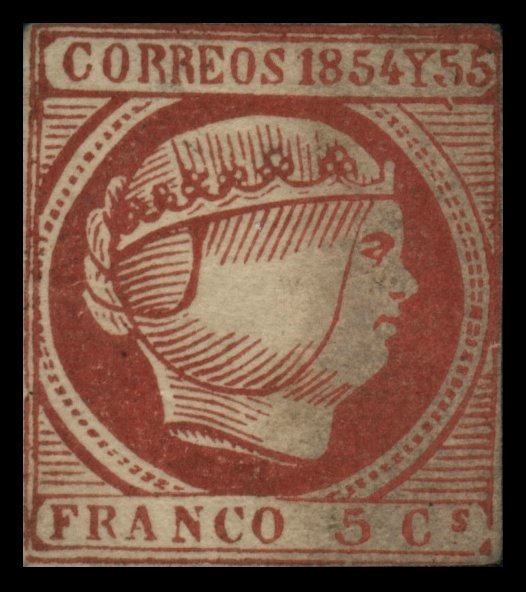
Gooding #6F5
The 'C' in 'CORREOS' is broad with a wide loop at the bottom and
the second 'R' has a small head and the right downward leg is to the right of
the head. There is a wide space between the 'E' and 'O'. The horizontal line
of '5' in '1854' ends in a dot, giving the appearance of it slanting
downward. The top horizontal line in the second '5' in '55' is wavy and the
bottom loop touches the frame line. Lettering in 'FRANCO' is thin.
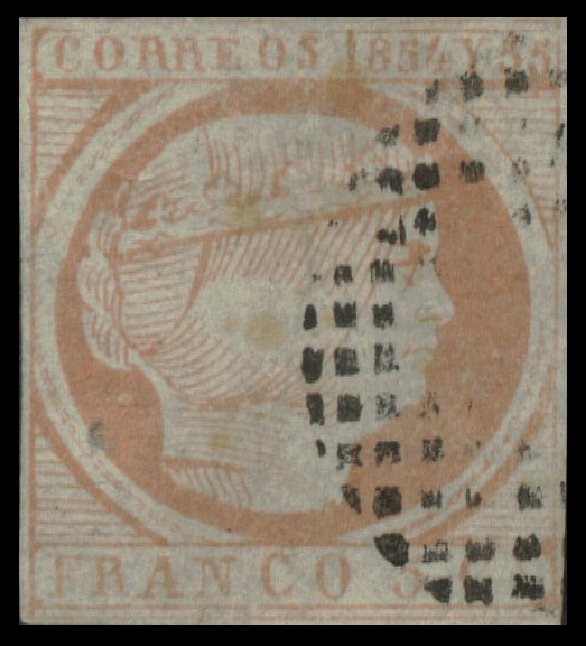
Gooding #6F6
BPA - Sperati Second Reproduction (Page 134)
Jean de Sperati
Forgery. Photo-Lithographed forgery closely resembling the second
variety. Stamp colour is bright red. The paper is a little harder and
somewhat thinner than the genuine. There are several major flaws in
'CORREOS'. The bottom serif of 'C' is curved. There is a break in the first
'O' at two o'clock. The
first 'R' has two indentations in the head and a white spot in the loop. In
the '1854' year date, the '1' has an indentation at the foot. The '5' has a
break in the upper side of the loop, a dot in the lower part and the end of
the figure terminates with a dot. Upper right corner is broken. There are
several major flaws in 'FRANCO'. Two white dots in 'R', one in the loop and
one in the tail. The upright of the 'N' is broken from the diagonal and the
right serif is broken from the right upright. Break in the circular frame
line at right, 9mm from the foot of the stamp. Semi-circular scratch below
the front of the neck which breaks the circular frame line and horizontal
frame line below, runs through the lead of the '5' and breaks the frame line
below. Die proofs exist in black and in colour as well as unused and used
reproductions. Some copies are known with a 'Sperati
Reproduction' handstamp on the back.
Gooding #6F7
The bottom part of the 'C' in 'CORREOS' consists of a straight
line with no curve. The top horizontal line in '5' of '1854' is thin. The top
of the '4' is thick. Serifs in '55' do not incline upward and are away from
the upper line. The left vertical line in 'N' of 'FRANCO' is bent at the top.
The bottom curve of the 'C' in 'FRANCO' is very thin, ending with in a large
dot. The circle of pearls is broken on the right side, leaving distinctive
white space. The second horizontal line in the lower right spandrel is short
and does not touch the right frame line. Largest
Known Multiple: Used Horizontal Pair (Nigel Gooding collection).
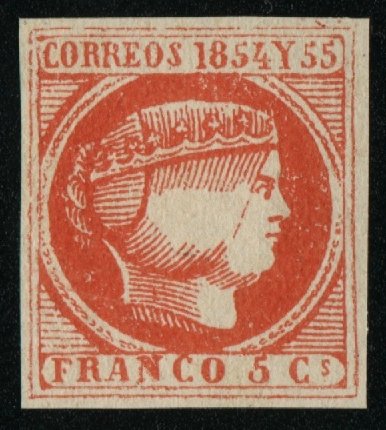
Gooding #6F8
The 'C' in 'CORREOS' is rounded and almost closed. The '4' of
'1854' is small, with the vertical line somewhat curved. The 'Y' is taller
compared to the numerals either side. The numbers '55' are small and the
serifs do not incline upward and are away from the upper line. The 'N' in
'FRANCO' is broken at the top left corner. The horizontal serif at the top of
the '5' is wavy. (Refer to Gooding
#6F17 for additional forgery with same die)
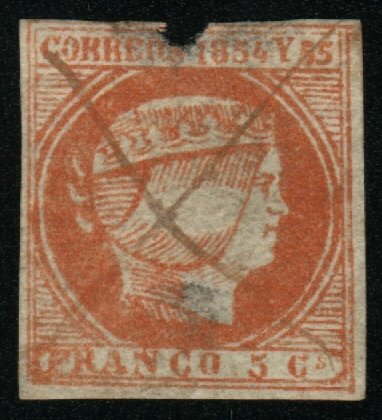
Gooding #6F9
A crude forgery and easily identifiable. All letters and numerals
are embossed. Circle of pearls are generally joined, appearing as a
continuous chain instead of individual circles.
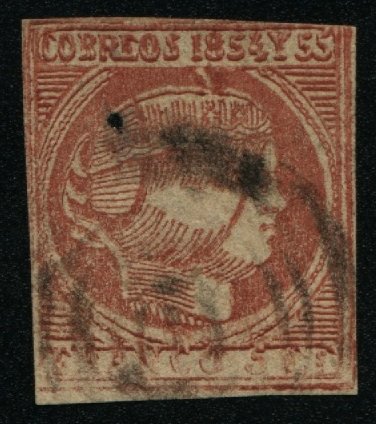
Gooding #6F10
The 'C' of 'CORREOS' is away from the left margin and the bottom
stroke of the second 'R' touches the 'E'. Horizontal staff in second '5' in
'55' has a short vertical line on the right side. The frameline
above 'COR' in 'CORREOS' is missing. Top left corner of the 'R' in 'FRANCO'
is broken. The 's' in 'Cs' is not very curved at
appears as a '5'. Largest Known
Multiple: Unused Block of 4 (Nigel Gooding collection).
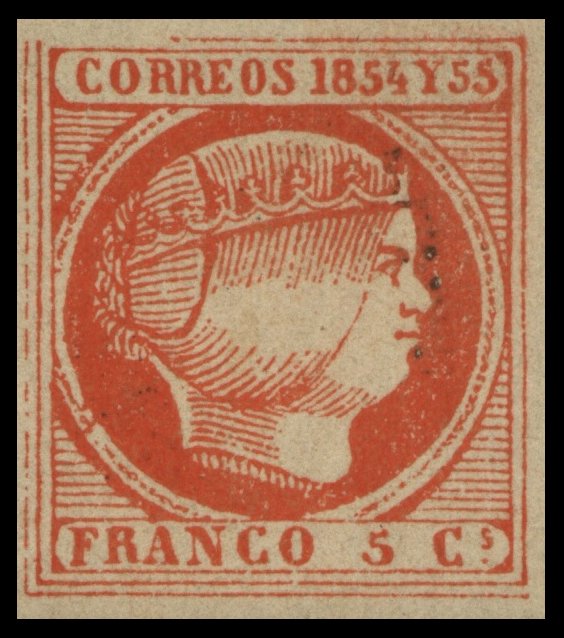
Gooding #6F11
The 'C' of 'CORREOS' is away
from the left margin and there is a larger than normal gap between the 'O'.
The '4' of '1854' is narrow and the horizontal line does not extend past the
vertical stroke. The right vertical line in 'N' of 'FRANCO' is thin and it
ends in a blob at the top.
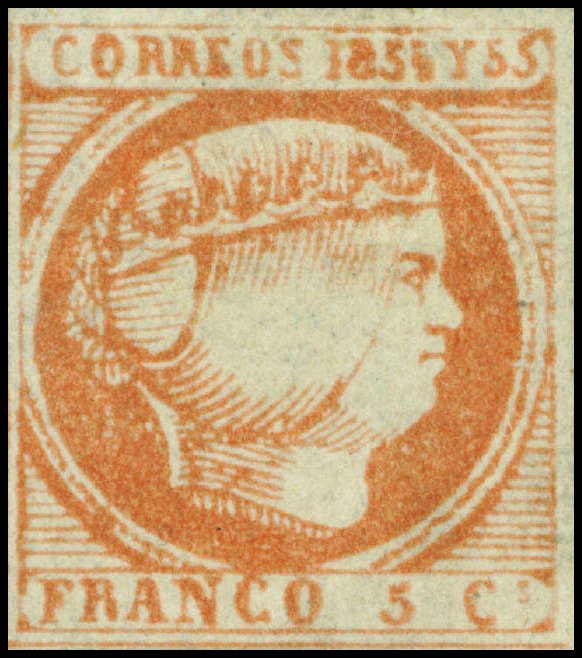
Gooding #6F12
A rather crude forgery in
orange. All the letters and numbers are large and of even size. None of the
horizontal lines touch the outer circle or the vertical borders. The pearls
are non-existent and are replaced with double lined dashes. Known used with
circle of dots cancellation.
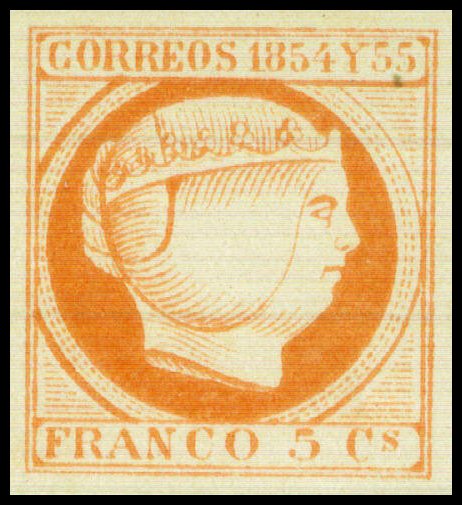
Gooding #6F13
The 'E' in 'CORREOS' is
malformed, with thick vertical line and virtually no centre line. The '5' in '1854'
has a very short top horizontal line. The circle of pearls is not consistent,
with quite a few pearls omitted providing gaps between pearls. The diagonal
line in 'N' of 'FRANCO' is very thick. The top horizontal line of '5' ends in
a blob and touches the line above it. The 'C' in 'Cs' is tall and touches the
lines above and below.
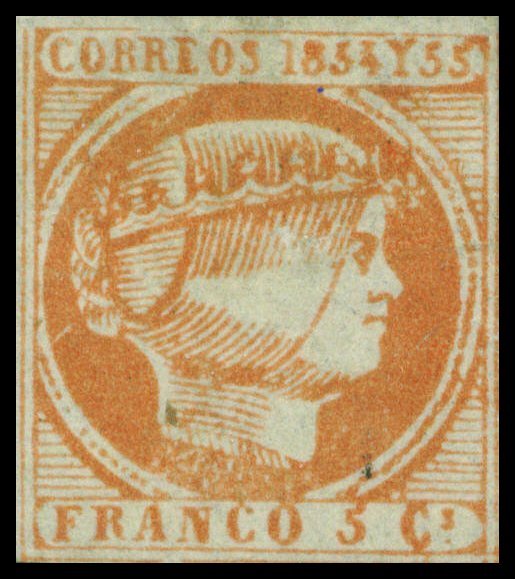
Gooding #6F14
Very crude and easily
identifiable forgery printed in black (imperforate), pale red (Imperforate
and Perforated) and dark green (Perforated). Circle of pearls appears as
double lined dashes. None of the lines in the spandrels touch the inner
circle or outer frame lines. Perforated stamps are most probably roulette).
All with bogus cancellations.
Gooding #6F15
A dangerous forgery. The 'C' in
'CORREOS' is taller than the other letters. The 'O' in 'FRANCO' is very
rounded compared to a more oblong shape in the genuine stamps. The solid
circle is not broken by the labels at the top and bottom. There are too many
horizontal lines in each corner around the circle of pearls. Known used with
bogus Parrilla cancel.
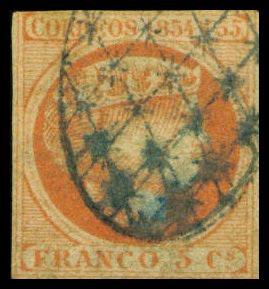
Gooding #6F16
A crude forgery issued in blue-grey (instead of vermilion) and with
a value of 10-Cuartos (instead of 5-Cuartos on the issued stamp). The circle
of pearls is formed of a solid line on either side of the Queen�s bust. The
'Y' is larger than the '1854' and '55'. Known used with bogus Circular Date
Cancellation. (Refer to Gooding #6F8
for additional forgery with same die)
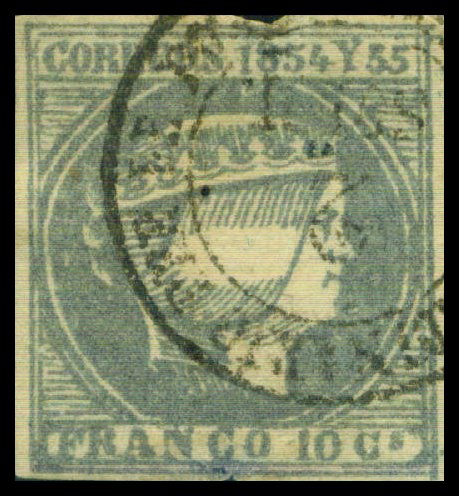
Gooding #6F17
A dangerous forgery in vermillion/salmon. The stamp measures
19.5mm x 22mm and most closely resembles the fourth variety of this issue. There
are only 8 lines on upper left of the spandrel compared to 9 in the normal
issue; and only 8 on the lower left of the spandrel compared to 10 in the
normal issue. The top of '5' in '1854' ends in large dot and almost touches
to top frame line. There is virtually no space between the 'Y' and '1854' and
'55'.
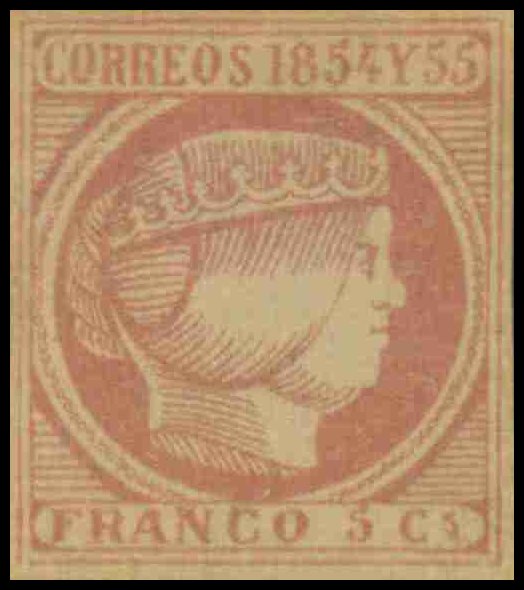
(BKD Dutch Expertising Committee)
Gooding #6F18
Crude forgery. The space between 'C' and 'O' of 'CORROES' is
wide and the 'E' is malformed at the top and forms a downward semi-circle.
The second '5' in '1855' has not staff on top and appears as a hook. Right
circle of pearls is formed of dashes, whilst left side if formed of very
small dots that are wide apart.
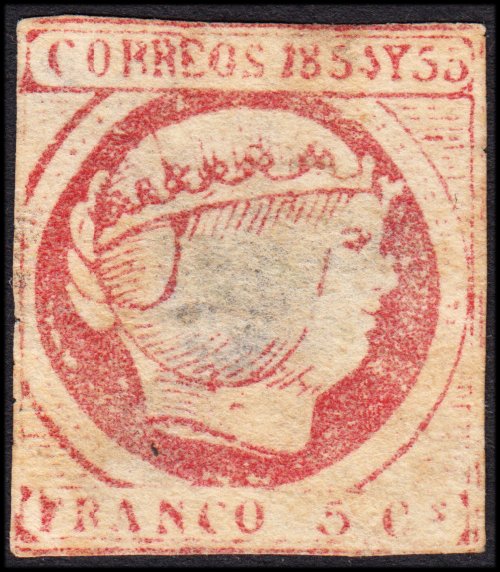
Gooding #6F19
Crude forgery. The 'C' of 'CORROES' is far away from the left
edge and all letters are of even height. All '5's in '1854 Y 55' are block
numbers with no serifs on top staff. Circle of pears on both sides are formed
of small dots, widely spaced apart. There are only four lines in each of the
upper and lower left corners. Used with bogus oblong grill cancel.
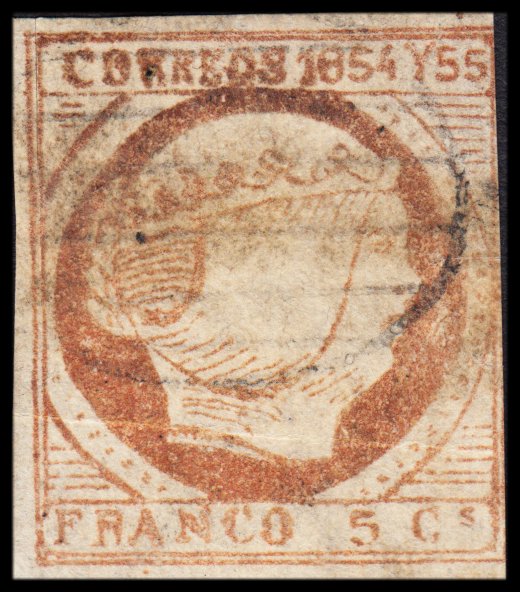
Gooding #6F20
One of two hand-drawn Facsimiles of this issue. Crude overall
appearance with letters, numbers and Queen's effigy significantly different
form the genuine issues. Stated to be part of around
250 individually unique hand-drawn stamps discovered in a cream-coloured stockbook belonging to a Walter D Young discovered in an
old desk by a Cabinet Maker in Woking, Surrey, UK around July 1951. Artist
remains unknown but evidently spent a great deal of time on his work.
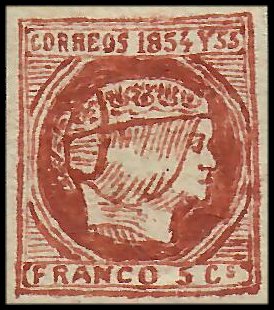
Gooding #6F21
One of two hand-drawn Facsimiles of this issue. Crude overall
appearance with letters, numbers and Queen's effigy significantly different
form the genuine issues. Stated to be part of around
250 individually unique hand-drawn stamps discovered in a cream-coloured stockbook belonging to a Walter D Young discovered in an
old desk by a Cabinet Maker in Woking, Surrey, UK around July 1951. Artist
remains unknown but evidently spent a great deal of time on his work.
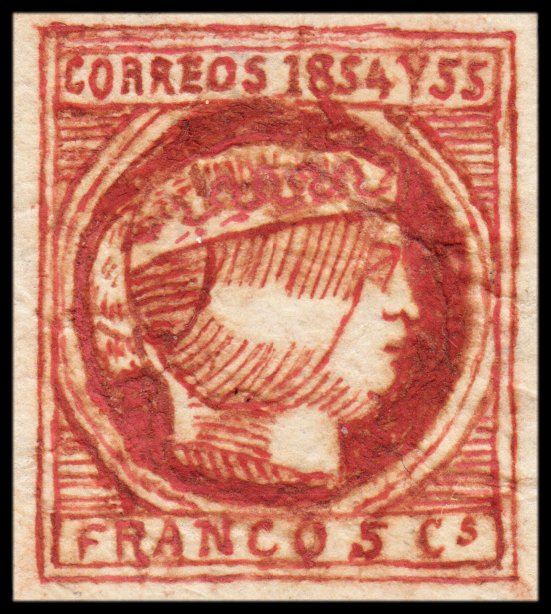
|
![]()
![]()
![]()
![]()
![]()
![]()
![]()
![]()
![]()
![]()